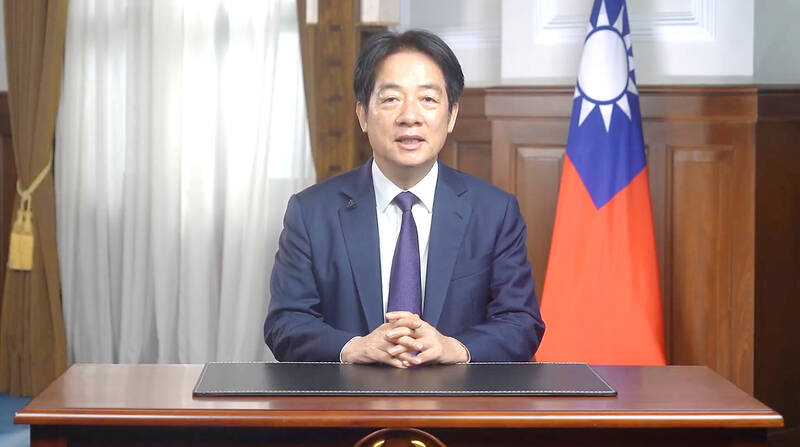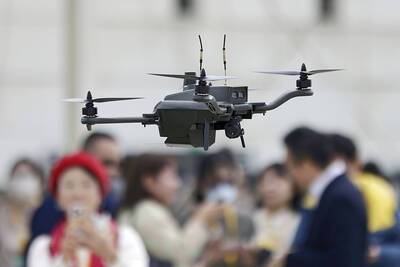The government would not impose reciprocal tariffs in retaliation against US levies, President William Lai (賴清德) said yesterday, as he announced five strategies to address the issue, including pledging to increase Taiwanese companies’ investments in the US.
Lai has in the past few days met with administrative and national security officials, as well as representatives from various industries, to explore countermeasures after US President Donald Trump on Wednesday last week announced a 32 percent duty on Taiwanese imports.
In a video released yesterday evening, Lai said that Taiwan would not retaliate against the US with higher tariffs and Taiwanese companies’ commitments to invest in the US would not change, as long as they are in the national interest.

Photo: Screen grab from the Presidential Office’s Flickr page
“Taiwanese exports to the US amounted to US$111.4 billion, or 23.4 percent of total exports, last year, while the other more than 75 percent of products were exported to other countries around the world,” he said.
“Of all exports to the US, competitive products, including information and communications [IT] products and electronic components, accounted for 65.4 percent, a figure that shows Taiwan’s economy is resilient,” Lai said, adding that the effects of increased US tariffs could be lessened through public-private cooperation.
Five strategies would be adopted to strengthen Taiwan-US industrial cooperation and bolster domestic industries, he said.
First, the government would seek a more preferable import duty from the US government through negotiations, including a “zero-for-zero” tariff approach in line with the US-Mexico-Canada Agreement, he said.
The government would expand procurement from the US to reduce the US trade deficit with Taiwan and encourage private investments in the US to deepen industrial cooperation, he said.
“Taiwan’s investments in the US have amounted to more than US$100 billion and created about 400,000 job opportunities,” Lai said.
In addition to Taiwan Semiconductor Manufacturing Co (台積電), companies from other industries in electronics, IT, and oil and gas are also encouraged to invest more in the US, he said.
The government would put together a task force to promote Taiwanese investments in the US, and would expect the US to reciprocate by integrating a team for US investments in Taiwan to tighten bilateral economic and trade cooperation, he said.
To facilitate negotiations, the government would try to remove nontariff trade barriers, which are indicators for the US to evaluate the fairness of trade, ease regulations on high-tech exports and clamp down on illicit transshipments, he said.
Second, the Cabinet would lead efforts to propose programs supporting businesses — particularly traditional industries, and small and medium-sized businesses — to innovate, upgrade or transform, Lai said.
Third, the government would propose medium and long-term economic development road maps and diversify overseas markets by collaborating with allied countries to integrate upstream, midstream and downstream industrial supply chains, he said.
Fourth, the national economic development strategy would be calibrated to focus on Taiwan-US industrial cooperation, while leveraging newly arranged international industrial chains to penetrate US markets and market Taiwanese products globally, he said.
Fifth, the government would invite advice from industries regardless of their type or scale to tailor policies to businesses’ needs and help ease the effects of the US’ “reciprocal” tariffs, he said.

The combined effect of the monsoon, the outer rim of Typhoon Fengshen and a low-pressure system is expected to bring significant rainfall this week to various parts of the nation, the Central Weather Administration (CWA) said. The heaviest rain is expected to occur today and tomorrow, with torrential rain expected in Keelung’s north coast, Yilan and the mountainous regions of Taipei and New Taipei City, the CWA said. Rivers could rise rapidly, and residents should stay away from riverbanks and avoid going to the mountains or engaging in water activities, it said. Scattered showers are expected today in central and

COOPERATION: Taiwan is aligning closely with US strategic objectives on various matters, including China’s rare earths restrictions, the Ministry of Foreign Affairs said Taiwan could deal with China’s tightened export controls on rare earth metals by turning to “urban mining,” a researcher said yesterday. Rare earth metals, which are used in semiconductors and other electronic components, could be recovered from industrial or electronic waste to reduce reliance on imports, National Cheng Kung University Department of Resources Engineering professor Lee Cheng-han (李政翰) said. Despite their name, rare earth elements are not actually rare — their abundance in the Earth’s crust is relatively high, but they are dispersed, making extraction and refining energy-intensive and environmentally damaging, he said, adding that many countries have opted to

SUPPLY CHAIN: Taiwan’s advantages in the drone industry include rapid production capacity that is independent of Chinese-made parts, the economic ministry said The Executive Yuan yesterday approved plans to invest NT$44.2 billion (US$1.44 billion) into domestic production of uncrewed aerial vehicles over the next six years, bringing Taiwan’s output value to more than NT$40 billion by 2030 and making the nation Asia’s democratic hub for the drone supply chain. The proposed budget has NT$33.8 billion in new allocations and NT$10.43 billion in existing funds, the Ministry of Economic Affairs said. Under the new development program, the public sector would purchase nearly 100,000 drones, of which 50,898 would be for civil and government use, while 48,750 would be for national defense, it said. The Ministry of

UNITED: The other candidates congratulated Cheng on her win, saying they hoped the new chair could bring the party to victory in the elections next year and in 2028 Former Chinese Nationalist Party (KMT) lawmaker Cheng Li-wun (鄭麗文) yesterday won the party’s chair election with 65,122 votes, or 50.15 percent of the votes. It was the first time Cheng, 55, ran for the top KMT post, and she is the second woman to hold the post of chair, following Hung Hsiu-chu (洪秀柱), who served from 2016 to 2017. Cheng is to succeed incumbent Eric Chu (朱立倫) on Nov. 1 for a four-year term. Cheng said she has spoken with the other five candidates and pledged to maintain party unity, adding that the party would aim to win the elections next year and